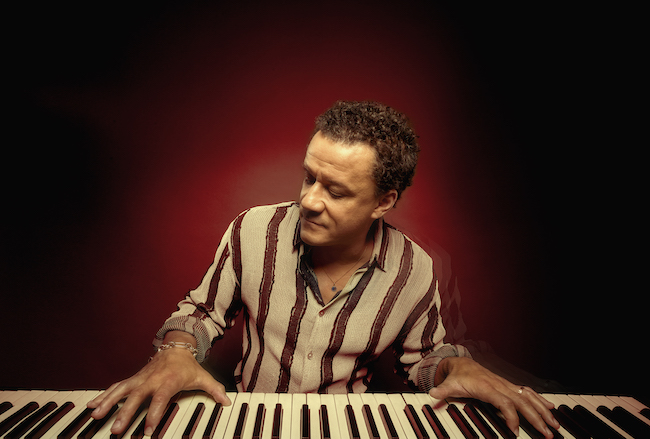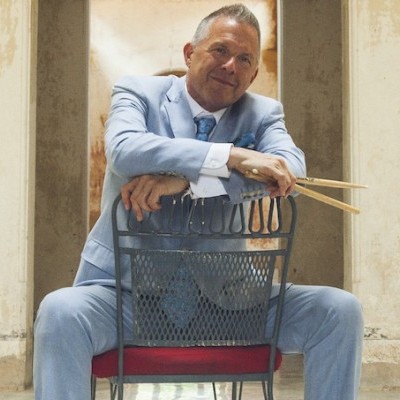Oct 28, 2025 10:47 AM
In Memoriam: Jack DeJohnette, 1942–2025
Jack DeJohnette, a bold and resourceful drummer and NEA Jazz Master who forged a unique vocabulary on the kit over his…

“All the musicians I admire are the ones that sound like their own vocabulary after a certain time,” Terrasson said about finding his own voice.
(Photo: Alexandre Lacombe)Jacky Terrasson has always gone his own special way, finding expressive routes to accommodate both deep musical traditions and sometimes sly innovations. The French piano virtuoso’s personalized balancing act is fully present and impressively showcased on his new album, Moving On, a relevant title on multiple fronts. His first post-pandemic release — and the first on his new Earth-Sounds label — arrives five years after his previous album 53 (yes, he is 58 now) on Blue Note. During that time between the two releases, Terrasson found himself moving from his long-time adopted home of New York City back to France to ride out the pandemic. Then, he decided it was time to settle back into his homeland.
Career and discography-wise, after battling frustrations in trying to get a new project out on a major label, Terrasson took the plunge into the self-determined, self-run label route: a path more easily navigated than ever before in the digital/social-media age.
Having long pent-up musical ideas and tracks finally go public is a cathartic moment, he admits. Those creative urges “were trapped inside for a long time,” he said. “This is the moment for all this energy to come out. I can’t wait to bring that repertoire on stage in live settings. It’s gonna be fun. Practicing is a great thing at home. To try to write is great, but my love is, well, being on stage and playing and sharing with other musicians and the audiences.”
Among other virtues, the new album boasts some of this jazz season’s most creatively — and lovingly — deconstructed versions of “Bésame Mucho,” “Misty” and Michel Legrand’s “I Will Wait For You.” The varied 15-track album also showcases his gift for infectious originals, including a title track redolent of the ’70s work of Keith Jarrett, a musician with whom he has often been compared.
Has it always been his goal to bring a fresh approach to well-trodden musical material? “Absolutely,” says Terrasson, on the phone from home in Paris. “Even if I’m gonna approach traditional material, I really take a pleasure in taking a melody out of its original context and putting it in a totally different environment. I like changing the colors, flavor, even the tempo, say, transforming your ballad into something speedier and vice versa.
“I’m really into cooking, and once you learn the recipes, you can allow yourself to take some freedom and change a little bit. I like to do it with standards or themes from movies or from folk or from the street.”
He also abides by the idea of bringing an open, improvisatory spirit into the studio, within some structural guidelines. “I like to be 65% prepared,” he says, “but not more. You have to let some stuff happen.”
Moving On was fittingly recorded in both France and New York, with his French trio allies Sylvain Romano and Lukmil Perez on bass and drums, and Americans Kenny Davis and Alvester Garnett, with cameos by drummers Billy Hart and Eric Harland. Distinctive vocals are provided by Kareen Gulock and Camille Bertault (on the serpentine “Are You Following Me?”), and chromatic harmonica master Grégoire Maret joins in with empathetic depth on “Happy” and on Terrasson’s sensuous, simmering original “Enfin.”
With an African-American mother from Georgia and a French father, Terrasson’s familial roots provide a groundwork for his layered cultural direction as a musician. After heading to the U.S. to study at Berklee, Terrasson quickly found his way into the ranks of respected new jazz figures in the early ’90s. Along the way, he has done more than his part in bringing French music into the discussion of jazz, throughout his career and especially on his 2000 album A Paris.
Beyond Terrasson’s ear-grabbingly reinventive standards, surprises await on Moving On’s track list, including a festive version of the Pharell Williams hit “Happy,” laced with the pianist’s own wily and most dissonant lines on the album. “I was not sure if we were gonna do that,” Terrasson comments. “But with Eric, the energy was just there, and we kept the first take. Boom. It’s a punchy one. It’s basically three chords, maybe four. But I like that the harmony and form is pretty easy — but now let me just try to blow as much as I can on this,” he recalls with a laugh.
Off in its own conceptual corner, his piece “Edith Piaf” nods to the legendary French chanteuse in a unique way, transcribing the sophisticated melody of a bird captured when walking through a jungle in Borneo. He points out that the bird (who deserves co-composer credit) has a melody that “is almost like serial music. You never repeat one note before you’ve done a whole 12-tone cycle.” To demonstrate, he plays the circular melody on his piano. “This is almost like [serial music architect Arnold] Schoenberg. I recorded it with my iPhone, and I was like, I’m gonna use it later.”
He also pays homage to his Paris-New York twin residency on the brisk, post-boppish “AF006,” titled after a popular transatlantic flight number. “I probably took that flight more than anyone in the world,” he laughs.
Capping the album off with a romantic and subtly metaphorical touch is a teasingly brief run through “Theme From New York, New York,” fading into the distance, like a departing plane. He confirms that the 53-second end track serves as “a symbol: We’re leaving, but we’ll be back. It ended up being faded out. I thought that a minute of that was just enough to leave you hungry.”
Circling back to the subject of finding new angles on familiar themes and performance modes, Terrasson does admit he “was kind of on a mission from the beginning. There’s only gonna be one Dexter [Gordon], one Bill Evans, one Thelonious Monk, one Ahmad Jamal, one Bud Powell. When you start out, it’s great to try to copy these guys. But eventually, you want to really try to present something.
“All the musicians I admire are the ones that sound like their own vocabulary after a certain time. And in terms of pianists, I like to use the word ‘eloquence.’ They really have their own way of freedom, you know? That’s really what it is. And, and picking out the right notes of the right words, or the right expressions, that’s a lifetime of work.”
Moving On also moves on from the standard definition of the time-honored piano trio format, with a structural freedom and collective heat-sensing impulse reminiscent of one of his true heroes, Jamal. In a piano trio, he notes, “the combination of the instruments is quite flexible. And there’s still enough space and enough material for more ideas to be found, more notions of space.”
With his impressive and long-awaited new album, and a new label to tend, Terrasson at 58 is embarking on the next phase of a long career as an important jazz voice. He’s emerging from a dark period over the past few years that many musicians and listeners alike can relate to. In this unfolding moment, Terrasson says, “It’s like more doors are opening. It’s also like jumping from a plane and saying, ‘Hey, I know I’m gonna land. I don’t know how, but I’m gonna land.’” DB

Jack DeJohnette boasted a musical resume that was as long as it was fearsome.
Oct 28, 2025 10:47 AM
Jack DeJohnette, a bold and resourceful drummer and NEA Jazz Master who forged a unique vocabulary on the kit over his…

Always a sharp dresser, Farnsworth wears a pocket square given to him by trumpeter Art Farmer. “You need to look good if you want to hang around me,” Farmer told him.
Sep 23, 2025 11:12 AM
When he was 12 years old, the hard-swinging veteran drummer Joe Farnsworth had a fateful encounter with his idol Max…

D’Angelo achieved commercial and critical success experimenting with a fusion of jazz, funk, soul, R&B and hip-hop.
Oct 14, 2025 1:47 PM
D’Angelo, a Grammy-winning R&B and neo-soul singer, guitarist and pianist who exerted a profound influence on 21st…

Kandace Springs channeled Shirley Horn’s deliberate phrasing and sublime self-accompaniment during her set at this year’s Pittsburgh International Jazz Festival.
Sep 30, 2025 12:28 PM
Janis Burley, the Pittsburgh International Jazz Festival’s founder and artistic director, did not, as might be…

Jim McNeely’s singular body of work had a profound and lasting influence on many of today’s top jazz composers in the U.S. and in Europe.
Oct 7, 2025 3:40 PM
Pianist Jim McNeely, one of the most distinguished large ensemble jazz composers of his generation, died Sept. 26 at…